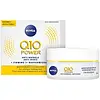What's inside
What's inside
 Key Ingredients
Key Ingredients

 Benefits
Benefits

 Concerns
Concerns

 Ingredients Side-by-side
Ingredients Side-by-side

Water
Skin ConditioningHomosalate
Skin ConditioningOctocrylene
UV AbsorberGlycerin
HumectantCyclomethicone
EmollientEthylhexyl Salicylate
UV AbsorberMethylpropanediol
SolventTapioca Starch
Butyl Methoxydibenzoylmethane
UV AbsorberPhenylbenzimidazole Sulfonic Acid
UV AbsorberBehenyl Alcohol
EmollientCetearyl Alcohol
EmollientUbiquinone
AntioxidantCreatine
Skin Conditioning1-Methylhydantoin-2-Imide
Skin ConditioningTocopheryl Acetate
AntioxidantXanthan Gum
Emulsifying1,2-Hexanediol
Skin ConditioningSodium Stearoyl Glutamate
CleansingAcrylates/C10-30 Alkyl Acrylate Crosspolymer
Emulsion StabilisingAmmonium Acryloyldimethyltaurate/Vp Copolymer
Trisodium EDTA
Sodium Chloride
MaskingSodium Hydroxide
BufferingPhenoxyethanol
PreservativeBenzyl Alcohol
PerfumingLimonene
PerfumingParfum
MaskingWater, Homosalate, Octocrylene, Glycerin, Cyclomethicone, Ethylhexyl Salicylate, Methylpropanediol, Tapioca Starch, Butyl Methoxydibenzoylmethane, Phenylbenzimidazole Sulfonic Acid, Behenyl Alcohol, Cetearyl Alcohol, Ubiquinone, Creatine, 1-Methylhydantoin-2-Imide, Tocopheryl Acetate, Xanthan Gum, 1,2-Hexanediol, Sodium Stearoyl Glutamate, Acrylates/C10-30 Alkyl Acrylate Crosspolymer, Ammonium Acryloyldimethyltaurate/Vp Copolymer, Trisodium EDTA, Sodium Chloride, Sodium Hydroxide, Phenoxyethanol, Benzyl Alcohol, Limonene, Parfum
Water
Skin ConditioningAlcohol Denat.
AntimicrobialEthylhexyl Methoxycinnamate
UV AbsorberButylene Glycol
HumectantDiphenylsiloxy Phenyl Trimethicone
Skin ConditioningDiethylamino Hydroxybenzoyl Hexyl Benzoate
UV FilterTitanium Dioxide
Cosmetic ColorantSodium Hyaluronate
HumectantSodium Ascorbyl Phosphate
AntioxidantOenothera Biennis Flower Extract
AstringentHydrolyzed Prunus Domestica
Skin ConditioningBarm Extract
Skin ConditioningBis-PEG-18 Methyl Ether Dimethyl Silane
EmollientMethyl Methacrylate Crosspolymer
Bis-Ethylhexyloxyphenol Methoxyphenyl Triazine
Skin ConditioningAcrylates Copolymer
Polysorbate 60
EmulsifyingAcrylates/C10-30 Alkyl Acrylate Crosspolymer
Emulsion StabilisingTriethanolamine
BufferingAmmonium Acryloyldimethyltaurate/Vp Copolymer
Silica
AbrasivePEG-12 Dimethicone
Skin ConditioningPolystyrene
Polyvinyl Alcohol
Disodium EDTA
Xanthan Gum
EmulsifyingAlumina
AbrasiveBHT
AntioxidantPolyglyceryl-2 Triisostearate
EmulsifyingSynthetic Fluorphlogopite
Tin Oxide
AbrasiveCI 45380
Cosmetic ColorantBlue 1 Lake
Cosmetic ColorantParfum
MaskingWater, Alcohol Denat., Ethylhexyl Methoxycinnamate, Butylene Glycol, Diphenylsiloxy Phenyl Trimethicone, Diethylamino Hydroxybenzoyl Hexyl Benzoate, Titanium Dioxide, Sodium Hyaluronate, Sodium Ascorbyl Phosphate, Oenothera Biennis Flower Extract, Hydrolyzed Prunus Domestica, Barm Extract, Bis-PEG-18 Methyl Ether Dimethyl Silane, Methyl Methacrylate Crosspolymer, Bis-Ethylhexyloxyphenol Methoxyphenyl Triazine, Acrylates Copolymer, Polysorbate 60, Acrylates/C10-30 Alkyl Acrylate Crosspolymer, Triethanolamine, Ammonium Acryloyldimethyltaurate/Vp Copolymer, Silica, PEG-12 Dimethicone, Polystyrene, Polyvinyl Alcohol, Disodium EDTA, Xanthan Gum, Alumina, BHT, Polyglyceryl-2 Triisostearate, Synthetic Fluorphlogopite, Tin Oxide, CI 45380, Blue 1 Lake, Parfum
 Reviews
Reviews

Ingredients Explained
These ingredients are found in both products.
Ingredients higher up in an ingredient list are typically present in a larger amount.
Acrylates/C10-30 Alkyl Acrylate Crosspolymer is a synthetic polymer. It is used to thicken and improve the texture of products. Due to its properties, it can prevent water and oil ingredients from separating.
Ammonium Acryloyldimethyltaurate/Vp Copolymer (let's call it AAVC for short) is a synthetically created polymer. It's used as a film-forming agent and used to thicken the consistency of products.
AAVC is able to increase the consistency and viscosity of products due to its large molecule size. It also prevents ingredients from separating.
Parfum is a catch-all term for an ingredient or more that is used to give a scent to products.
Also called "fragrance", this ingredient can be a blend of hundreds of chemicals or plant oils. This means every product with "fragrance" or "parfum" in the ingredients list is a different mixture.
For instance, Habanolide is a proprietary trade name for a specific aroma chemical. When used as a fragrance ingredient in cosmetics, most aroma chemicals fall under the broad labeling category of “FRAGRANCE” or “PARFUM” according to EU and US regulations.
The term 'parfum' or 'fragrance' is not regulated in many countries. In many cases, it is up to the brand to define this term.
For instance, many brands choose to label themselves as "fragrance-free" because they are not using synthetic fragrances. However, their products may still contain ingredients such as essential oils that are considered a fragrance by INCI standards.
One example is Calendula flower extract. Calendula is an essential oil that still imparts a scent or 'fragrance'.
Depending on the blend, the ingredients in the mixture can cause allergies and sensitivities on the skin. Some ingredients that are known EU allergens include linalool and citronellol.
Parfum can also be used to mask or cover an unpleasant scent.
The bottom line is: not all fragrances/parfum/ingredients are created equally. If you are worried about fragrances, we recommend taking a closer look at an ingredient. And of course, we always recommend speaking with a professional.
Learn more about ParfumWater. It's the most common cosmetic ingredient of all. You'll usually see it at the top of ingredient lists, meaning that it makes up the largest part of the product.
So why is it so popular? Water most often acts as a solvent - this means that it helps dissolve other ingredients into the formulation.
You'll also recognize water as that liquid we all need to stay alive. If you see this, drink a glass of water. Stay hydrated!
Learn more about WaterXanthan gum is used as a stabilizer and thickener within cosmetic products. It helps give products a sticky, thick feeling - preventing them from being too runny.
On the technical side of things, xanthan gum is a polysaccharide - a combination consisting of multiple sugar molecules bonded together.
Xanthan gum is a pretty common and great ingredient. It is a natural, non-toxic, non-irritating ingredient that is also commonly used in food products.
Learn more about Xanthan Gum